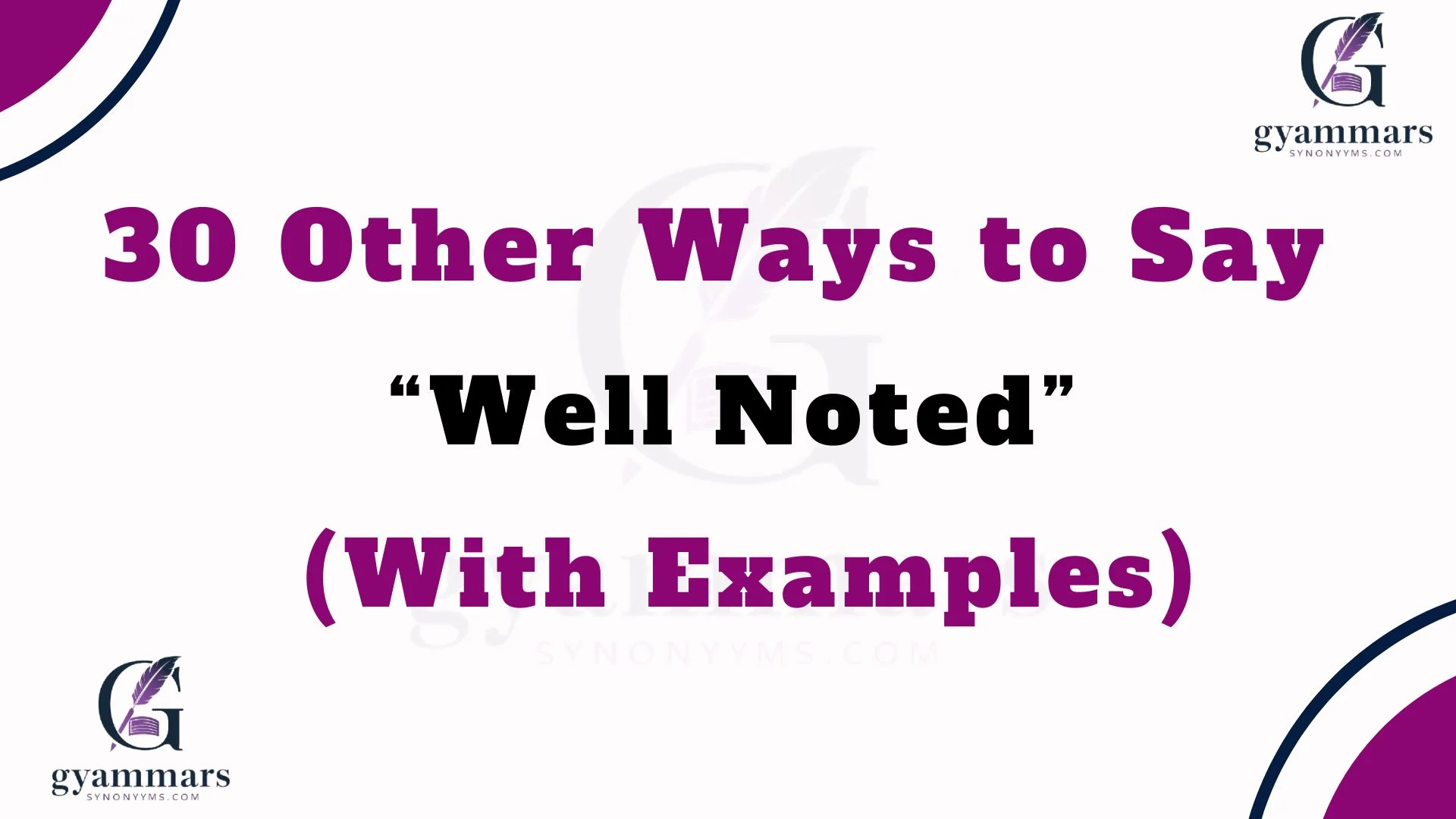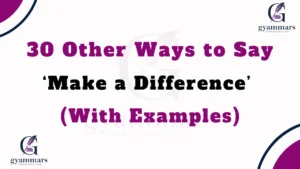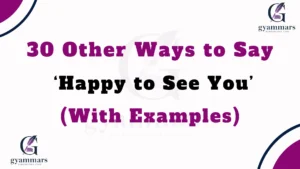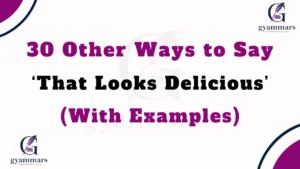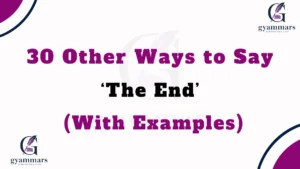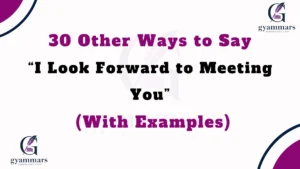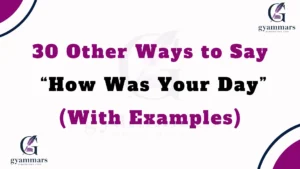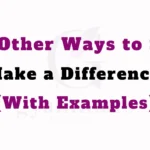Finding the right words in professional communication can make a significant difference. Saying “Well Noted” may feel straightforward, but sometimes it comes across as cold or impersonal. Using thoughtful alternatives allows you to express acknowledgment with warmth, clarity, and professionalism. These alternatives can make your messages feel more personal, attentive, and considerate, which is especially valuable in work emails, client communication, or team collaboration.
What Does “Well Noted” Mean?
Definition: “Well Noted” is a concise way to acknowledge receipt of information or instructions. Explanation: It communicates that you have understood the message, but it can sometimes feel brief or detached. Scenario Example: Your manager emails you instructions on a new project. You reply: “Well Noted.” Best Use: Quick acknowledgment in professional settings. Tone: Neutral, formal. Additional Notes: Overuse can seem dismissive; consider alternatives to convey attentiveness.
Is It Professional/Polite to Say “Well Noted”?
Yes, it is generally professional and polite, but context matters. It works best in formal emails or when acknowledging instructions without requiring discussion. However, in collaborative or client-facing communication, using a warmer alternative may leave a better impression.
Pros or Cons of Saying “Well Noted”
Pros:
- Clear acknowledgment
- Quick and concise
- Maintains professional tone
Cons:
- Can feel abrupt
- Lacks warmth
- May seem dismissive if overused
Synonyms For “Well Noted”
- Duly Noted
- Understood
- Got It
- Acknowledged
- Noted with Thanks
- Message Received
- I’ve Taken Note
- Thank You for the Update
- I Appreciate the Information
- I Have Noted Your Points
- Logged
- Copy That
- Affirmative
- I Will Take Note of This
- Duly Acknowledged
- I Take Your Point
- Point Taken
- Noted and Appreciated
- Heard and Understood
- I Have Recorded This
- I Understand
- Thanks for Highlighting This
- I Will Keep This in Mind
- Your Message is Noted
- Acknowledgment Received
- I’ll Note That
- I’ve Got That
- Recognized
- Logged and Understood
- Considered
1. Duly Noted
Definition: Formally acknowledges that information has been received and understood.
Detailed Explanation: “Duly Noted” is slightly more formal than “Well Noted” and adds a touch of professionalism.
Scenario Example: Your client sends updated project requirements. Reply: “Duly noted, thank you for sharing the details.”
Best Use: Formal correspondence with superiors or clients.
Tone: Formal, professional, respectful
Additional Notes: Use sparingly; best suited for hierarchical or legal communication.
2. Understood
Definition: A straightforward acknowledgment indicating comprehension.
Detailed Explanation: It emphasizes that the message or instruction is fully understood.
Scenario Example: Team lead emails a new deadline: “Understood. I’ll ensure the report is submitted on time.”
Best Use: Internal team emails or confirming instructions.
Tone: Neutral, confident
Additional Notes: Can be perceived as curt in external emails—softening phrases may help.
3. Got It
Definition: Informal way of confirming receipt and understanding of a message.
Detailed Explanation: Friendly and casual, suitable for colleagues or peers.
Scenario Example: Your teammate assigns a task: “Got it, I’ll start working on this now.”
Best Use: Internal communication, chat apps, or casual emails.
Tone: Friendly, approachable
Additional Notes: Avoid in highly formal or client-facing emails.
4. Acknowledged
Definition: Confirms receipt and awareness of information.
Detailed Explanation: More neutral and professional; communicates receipt without additional commentary.
Scenario Example: Supervisor provides instructions: “Acknowledged. I will follow up accordingly.”
Best Use: Military, official, or formal professional emails.
Tone: Formal, neutral
Additional Notes: Very concise; may appear cold if used excessively.
5. Noted with Thanks
Definition: Acknowledges the information while expressing gratitude.
Detailed Explanation: Adds a polite and warm touch, showing appreciation for the sender’s effort.
Scenario Example: Client sends additional data: “Noted with thanks. I will review and revert shortly.”
Best Use: Client communication, polite acknowledgments.
Tone: Courteous, professional
Additional Notes: Balances acknowledgment with appreciation.
6. Message Received
Definition: Indicates that the message has been received and understood.
Detailed Explanation: Clear and direct; commonly used in formal emails.
Scenario Example: Manager shares meeting notes: “Message received. I will implement the recommendations.”
Best Use: Professional and formal internal emails.
Tone: Neutral, formal
Additional Notes: Can seem robotic; consider adding a warm line for softer tone.
7. I’ve Taken Note
Definition: Shows that the information has been consciously recorded or remembered.
Detailed Explanation: Communicates active acknowledgment rather than just passive receipt.
Scenario Example: HR sends policy update: “I’ve taken note of the changes and will adhere to them.”
Best Use: Professional correspondence where understanding and compliance are essential.
Tone: Professional, attentive
Additional Notes: Slightly formal; suitable for structured emails.
8. Thank You for the Update
Definition: Acknowledges receipt while expressing gratitude.
Detailed Explanation: Warms up a simple acknowledgment with politeness.
Scenario Example: Team member sends status update: “Thank you for the update. Noted and appreciated.”
Best Use: Emails with recurring updates or progress reports.
Tone: Polite, appreciative
Additional Notes: Works well in external or client-facing emails.
9. I Appreciate the Information
Definition: Shows recognition and gratitude for the shared details.
Detailed Explanation: Adds a personal touch and expresses that the sender’s effort is valued.
Scenario Example: Client sends important specifications: “I appreciate the information. I’ll incorporate it in the project.”
Best Use: Formal emails with polite acknowledgment.
Tone: Courteous, respectful
Additional Notes: Slightly warmer than “Well Noted.”
10. I Have Noted Your Points
Definition: Specifies acknowledgment of individual points shared.
Detailed Explanation: Highlights that you carefully reviewed and understood specific details.
Scenario Example: Colleague provides multiple instructions: “I have noted your points and will address each accordingly.”
Best Use: Emails with detailed instructions or feedback.
Tone: Professional, attentive
Additional Notes: Effective for structured acknowledgment.
11. Logged
Definition: Confirms that the information has been recorded in official logs or systems.
Detailed Explanation: Often used in operational or technical environments.
Scenario Example: IT team sends incident report: “Logged. We will proceed with the next steps.”
Best Use: Technical, operational, or internal documentation.
Tone: Formal, neutral
Additional Notes: Minimal warmth; best in technical contexts.
12. Copy That
Definition: Informal acknowledgment, mostly used in conversational or chat-style emails.
Detailed Explanation: Indicates comprehension, inspired by radio or military communication.
Scenario Example: Team chat: “Copy that, I’ll handle the task.”
Best Use: Internal team chats or casual emails.
Tone: Casual, friendly
Additional Notes: Avoid formal emails; can be too casual for clients.
13. Affirmative
Definition: Confirms understanding in a formal or precise way.
Detailed Explanation: Often used in official, technical, or military communication.
Scenario Example: Supervisor issues instructions: “Affirmative, I will proceed as advised.”
Best Use: Formal or technical communication.
Tone: Neutral, formal
Additional Notes: Not recommended for casual or client-facing emails.
14. I Will Take Note of This
Definition: Shows proactive acknowledgment and intent to act.
Detailed Explanation: Indicates understanding and commitment to remember the information.
Scenario Example: Manager assigns a long-term task: “I will take note of this and provide updates weekly.”
Best Use: Professional correspondence with ongoing responsibilities.
Tone: Professional, attentive
Additional Notes: Slightly formal; softens acknowledgment.
15. Duly Acknowledged
Definition: Formal acknowledgment showing that the information has been properly received.
Detailed Explanation: Adds ceremonial or official tone to the acknowledgment.
Scenario Example: Legal team sends notice: “Duly acknowledged. Thank you for the information.”
Best Use: Legal, regulatory, or highly formal emails.
Tone: Formal, respectful
Additional Notes: Very formal; use in official or hierarchical contexts.
16. I Take Your Point
Definition: Shows understanding and recognition of the sender’s perspective.
Detailed Explanation: Communicates active listening and consideration.
Scenario Example: Colleague shares a concern: “I take your point. Let’s address it in the next meeting.”
Best Use: Emails discussing opinions or perspectives.
Tone: Polite, empathetic
Additional Notes: Warm alternative; suitable for collaborative environments.
17. Point Taken
Definition: Concise acknowledgment indicating understanding of the message or advice.
Detailed Explanation: Informal but professional; can soften authoritative statements.
Scenario Example: Manager gives feedback: “Point taken. I’ll make the necessary adjustments.”
Best Use: Professional emails with constructive feedback.
Tone: Neutral, polite
Additional Notes: Works best in internal communication.
18. Noted and Appreciated
Definition: Combines acknowledgment with gratitude.
Detailed Explanation: Warms up acknowledgment, expressing thankfulness alongside receipt.
Scenario Example: Client sends detailed instructions: “Noted and appreciated. We’ll implement this immediately.”
Best Use: Client-facing and formal communication.
Tone: Courteous, respectful
Additional Notes: Very professional and polite.
Also Read This : 30 Other Ways to Say ‘Calm Your Tits’ (With Examples)
19. Heard and Understood
Definition: Confirms both receipt and comprehension.
Detailed Explanation: Slightly informal; emphasizes active listening.
Scenario Example: Team member updates task: “Heard and understood. I’ll adjust accordingly.”
Best Use: Internal team communication.
Tone: Neutral, approachable
Additional Notes: Casual alternative for team emails.
20. I Have Recorded This
Definition: Indicates that the information is officially noted or documented.
Detailed Explanation: Formal acknowledgment used in structured workflows.
Scenario Example: HR shares policy: “I have recorded this and will update the records.”
Best Use: Internal documentation or compliance emails.
Tone: Formal, neutral
Additional Notes: Minimal warmth; focuses on documentation.
21. I Understand
Definition: Shows comprehension without needing further clarification.
Detailed Explanation: Simple, direct, and professional.
Scenario Example: Supervisor instructs a task: “I understand. I’ll follow your guidance.”
Best Use: Professional internal emails or instructions.
Tone: Neutral, polite
Additional Notes: Can be softened with “Thank you” for warmth.
22. Thanks for Highlighting This
Definition: Expresses gratitude for bringing information to attention.
Detailed Explanation: Polite and empathetic; emphasizes appreciation.
Scenario Example: Colleague shares potential issue: “Thanks for highlighting this. I’ll address it immediately.”
Best Use: Collaborative emails or proactive communication.
Tone: Polite, warm
Additional Notes: Adds human touch; avoids cold acknowledgment.
23. I Will Keep This in Mind
Definition: Indicates that the information will be remembered and acted upon.
Detailed Explanation: Soft acknowledgment, showing thoughtfulness and intention.
Scenario Example: Client suggests feedback: “I will keep this in mind for future updates.”
Best Use: Situations requiring consideration rather than immediate action.
Tone: Warm, thoughtful
Additional Notes: Good for feedback or advisory situations.
24. Your Message is Noted
Definition: Direct acknowledgment of receipt of a message.
Detailed Explanation: Clear, formal acknowledgment without extra phrasing.
Scenario Example: Partner sends instructions: “Your message is noted. We will follow the guidelines.”
Best Use: Formal correspondence.
Tone: Neutral, professional
Additional Notes: Can feel impersonal; add “Thank you” for warmth.
25. Acknowledgment Received
Definition: Confirms the receipt of information in a formal tone.
Detailed Explanation: Official, used for formal acknowledgment purposes.
Scenario Example: Regulatory document received: “Acknowledgment received. We’ll proceed as instructed.”
Best Use: Formal or legal correspondence.
Tone: Neutral, official
Additional Notes: Minimal warmth; appropriate for compliance emails.
26. I’ll Note That
Definition: Informal acknowledgment indicating intent to remember or consider.
Detailed Explanation: Casual, friendly, suitable for peer-to-peer communication.
Scenario Example: Team chat: “I’ll note that for our next meeting.”
Best Use: Internal team communication.
Tone: Casual, approachable
Additional Notes: Avoid in highly formal contexts.
27. I’ve Got That
Definition: Confirms understanding, similar to “Got it,” but slightly warmer.
Detailed Explanation: Casual acknowledgment, suitable for familiar colleagues.
Scenario Example: Teammate sends instructions: “I’ve got that. I’ll handle it.”
Best Use: Informal or internal emails.
Tone: Friendly, approachable
Additional Notes: Avoid external or formal emails.
28. Recognized
Definition: Professional acknowledgment, emphasizing recognition.
Detailed Explanation: Slightly formal, communicates active awareness.
Scenario Example: HR sends notice: “Recognized. We will implement the changes accordingly.”
Best Use: Formal internal or client emails.
Tone: Neutral, professional
Additional Notes: Minimal warmth; best in formal settings.
29. Logged and Understood
Definition: Confirms that the information is both recorded and comprehended.
Detailed Explanation: Common in operational or technical contexts.
Scenario Example: IT department updates system instructions: “Logged and understood. I’ll proceed with the steps.”
Best Use: Technical or operational emails.
Tone: Neutral, formal
Additional Notes: Clear and precise; lacks warmth.
30. Considered
Definition: Indicates that the information has been reviewed thoughtfully.
Detailed Explanation: Suggests deliberate attention to details shared.
Scenario Example: Manager provides feedback: “Considered. I will incorporate these suggestions in the plan.”
Best Use: Professional communication involving thoughtful review.
Tone: Professional, attentive
Additional Notes: Adds a slightly reflective tone compared to plain acknowledgment.
Conclusion
Choosing alternatives to “Well Noted” can enhance professionalism, warmth, and clarity in your emails. Depending on the context—whether internal communication, client interaction, or formal documentation—you can select an acknowledgment that best suits the tone you want to convey. Using these alternatives thoughtfully ensures that your messages feel personal, attentive, and considerate while maintaining clarity and efficiency.
❓ FAQs About Saying “Well Noted” in Emails
1. Is it rude to say “Well Noted”?
No, it’s not rude. It’s professional and concise, but if overused, it may come across as cold or dismissive.
2. What can I say instead of “Well Noted” in a formal email?
You can use phrases like “Duly Noted,” “Acknowledged,” “Message Received,” or “Noted with Thanks.”
3. Is “Well Noted” better for internal or client emails?
It works best in internal or formal emails, but for client communication, warmer options like “Thank you for the update” may leave a better impression.
4. Can I use “Got It” in professional emails?
Yes, but only in casual or internal communication. For external or client-facing emails, choose a more formal alternative.
5. What is the most polite alternative to “Well Noted”?
Polite choices include “Noted with Thanks,” “I Appreciate the Information,” or “Thanks for Highlighting This.”

“Emma Rose at Grammar Synonyms is your go-to expert for everything related to language and expression. Whether you’re refining your grammar, searching for the perfect synonym, or looking for creative ways to improve your writing, Emma Rose provides the tools and inspiration you need. With a wide range of resources designed to elevate your communication, Grammar Synonyms helps you find just the right words to make every sentence shine.
